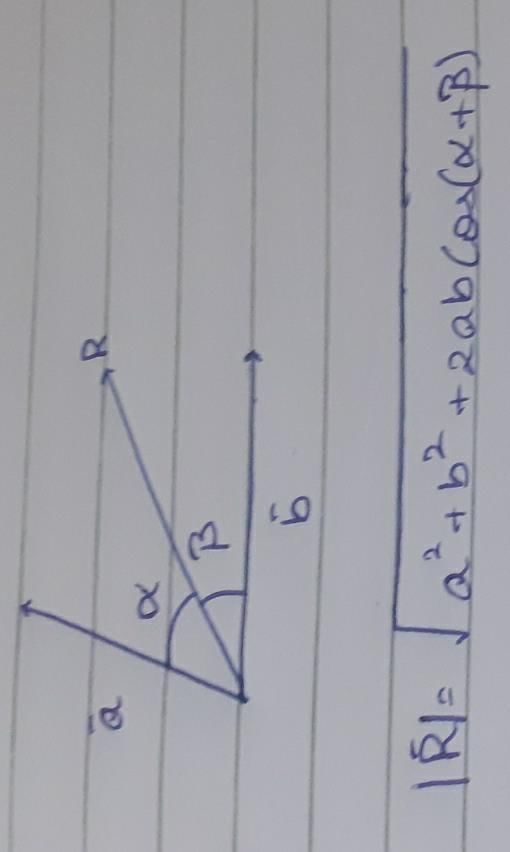NEET Exam > NEET Questions > Two vectors a and b make angle alpha and beta...
Start Learning for Free
Two vectors a and b make angle alpha and beta respectively with their resultant vector then magnitude of the resultant vector is?
Most Upvoted Answer
Two vectors a and b make angle alpha and beta respectively with their ...

Community Answer
Two vectors a and b make angle alpha and beta respectively with their ...
There are two vectors, a and b, making angles alpha and beta respectively with their resultant vector. We need to find the magnitude of the resultant vector.
- Vector Addition:
When two vectors are added, their resultant vector can be found using vector addition. The resultant vector is the vector sum of the two given vectors.
- Law of Cosines:
In this case, we can use the Law of Cosines to find the magnitude of the resultant vector. The Law of Cosines states that in a triangle, the square of one side is equal to the sum of the squares of the other two sides minus twice the product of the two sides and the cosine of the included angle.
- Calculation:
Let's assume the magnitude of vector a is A, the magnitude of vector b is B, and the magnitude of the resultant vector is R.
According to the Law of Cosines:
R^2 = A^2 + B^2 - 2ABcos(180 - (alpha + beta))
R^2 = A^2 + B^2 + 2ABcos(alpha + beta)
- Angle between Resultant and Vectors:
The angle between the resultant vector and vector a can be found using the Law of Sines or the Law of Cosines. Similarly, the angle between the resultant vector and vector b can also be calculated.
- Final Step:
Once you have the magnitude of the resultant vector, you can also find the direction of the resultant vector by calculating the angle it makes with the x-axis or any other reference axis.
By following these steps and calculations, you can determine the magnitude of the resultant vector when given the angles alpha and beta that vectors a and b make with the resultant vector.
Attention NEET Students!
To make sure you are not studying endlessly, EduRev has designed NEET study material, with Structured Courses, Videos, & Test Series. Plus get personalized analysis, doubt solving and improvement plans to achieve a great score in NEET.

|
Explore Courses for NEET exam
|

|
Similar NEET Doubts
Two vectors a and b make angle alpha and beta respectively with their resultant vector then magnitude of the resultant vector is?
Question Description
Two vectors a and b make angle alpha and beta respectively with their resultant vector then magnitude of the resultant vector is? for NEET 2024 is part of NEET preparation. The Question and answers have been prepared according to the NEET exam syllabus. Information about Two vectors a and b make angle alpha and beta respectively with their resultant vector then magnitude of the resultant vector is? covers all topics & solutions for NEET 2024 Exam. Find important definitions, questions, meanings, examples, exercises and tests below for Two vectors a and b make angle alpha and beta respectively with their resultant vector then magnitude of the resultant vector is?.
Two vectors a and b make angle alpha and beta respectively with their resultant vector then magnitude of the resultant vector is? for NEET 2024 is part of NEET preparation. The Question and answers have been prepared according to the NEET exam syllabus. Information about Two vectors a and b make angle alpha and beta respectively with their resultant vector then magnitude of the resultant vector is? covers all topics & solutions for NEET 2024 Exam. Find important definitions, questions, meanings, examples, exercises and tests below for Two vectors a and b make angle alpha and beta respectively with their resultant vector then magnitude of the resultant vector is?.
Solutions for Two vectors a and b make angle alpha and beta respectively with their resultant vector then magnitude of the resultant vector is? in English & in Hindi are available as part of our courses for NEET.
Download more important topics, notes, lectures and mock test series for NEET Exam by signing up for free.
Here you can find the meaning of Two vectors a and b make angle alpha and beta respectively with their resultant vector then magnitude of the resultant vector is? defined & explained in the simplest way possible. Besides giving the explanation of
Two vectors a and b make angle alpha and beta respectively with their resultant vector then magnitude of the resultant vector is?, a detailed solution for Two vectors a and b make angle alpha and beta respectively with their resultant vector then magnitude of the resultant vector is? has been provided alongside types of Two vectors a and b make angle alpha and beta respectively with their resultant vector then magnitude of the resultant vector is? theory, EduRev gives you an
ample number of questions to practice Two vectors a and b make angle alpha and beta respectively with their resultant vector then magnitude of the resultant vector is? tests, examples and also practice NEET tests.

|
Explore Courses for NEET exam
|

|
Suggested Free Tests
Signup for Free!
Signup to see your scores go up within 7 days! Learn & Practice with 1000+ FREE Notes, Videos & Tests.

























